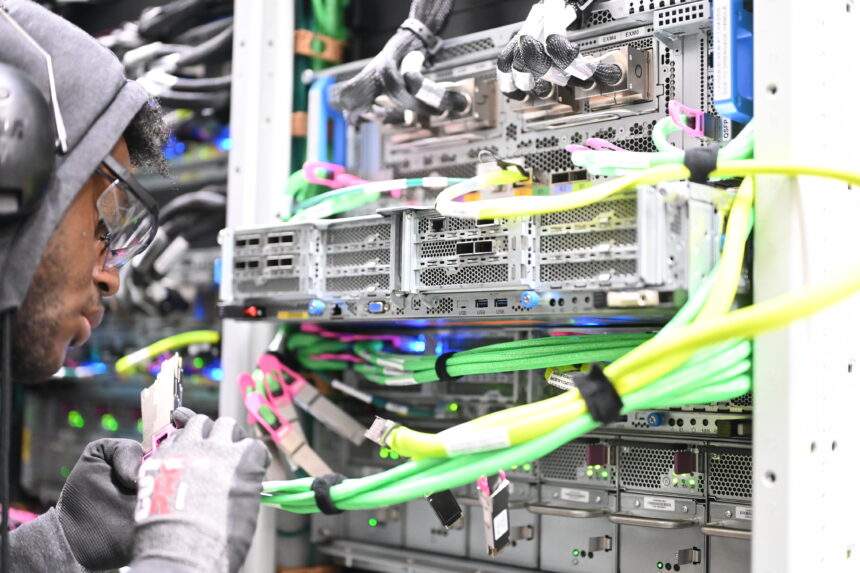Among Grant County’s corn, hay and potato fields, 29 data centers have created an unlikely economic boom, helping drive annual property taxes up 1,277% to $54 million over nearly two decades. The town of Quincy, which hosts most of the facilities, has used its share of tax revenue to transform the Eastern Washington community’s rural infrastructure — funding everything from a new school, hospital and fire station to plans for a deluxe soccer complex to draw tourists.
But Quincy’s windfall captures the complex tradeoffs that Washington and other states face as data center development booms nationwide. While the computing facilities generate substantial tax revenue and create jobs, they’re also straining the electrical grid, gulping valuable water, and threatening efforts to ditch fossil fuel-powered energy. The competing interests are sparking opposition in communities in Virginia and Arizona where the downsides are being more acutely felt.
Earlier this year, Gov. Bob Ferguson created a workgroup to examine the potential impacts of data centers on Washington’s economy and environment. The group faces a Dec. 1 deadline for policy recommendations that could accelerate or slow future projects — a decision made more urgent by President Trump’s AI Action Plan, which aims to slash regulations to speed data center construction supporting artificial intelligence.
“We must ensure Washington remains a leader in technology and sustainability — these experts will help us do that,” Ferguson said in announcing the workgroup.
Courting data centers
Washington has actively courted data center growth, passing state tax breaks in 2010 to encourage their construction in rural regions and expanding those incentives to urban settings in 2022. The state, which is home to two of the world’s biggest cloud and AI companies — Microsoft and Amazon — now ranks 10th nationally with 128 data centers.
In addition to the boost in property taxes from the biggest taxpayers, Quincy and neighboring East Wenatchee were able to drop the rates for other parcels, according to draft findings from Washington’s Data Center Workgroup. In 2006, before data centers began cropping up, property owners in Quincy were paying about $3 per thousand dollars of assessed value for their land. That rate shrank to less than $1 dollar per thousand today.
Last year, Voltage Park opened a data center in Quincy and another in Puyallup, located south of Seattle. The company, which serves AI startups and global enterprises, cited tax breaks, clean energy access, and introductions to state universities for engineering talent development as key factors in choosing Washington.
“The local business and political community has been a big source of support for us,” said Elliot Darvick, Voltage Park’s senior vice president of operations and people, via email.
Rising energy demand, electricity costs
But the development comes with mounting costs. Electricity rates in Washington have jumped 86% over nearly 20 years — outpacing the 51% national average, according to U.S. Energy Information Administration data. While multiple factors contribute to the rise, the data centers certainly play a role.
The facilities now consume 5.7% of Washington’s total electricity production, according to a Sightline Institute study. And that share is expected to grow as AI applications expand. Public utility districts report receiving requests from data center companies that would double or even triple their current electrical loads, a preliminary workgroup document revealed.
The timing is problematic. Energy demand is outstripping new clean energy deployments, and the Trump administration has recently rescinded permits for renewable projects, including a major wind farm planned in Idaho. This dynamic is pushing utilities toward continued reliance on natural gas plants, potentially undermining Washington’s climate goals.
Water consumption adds another layer of concern, as many data centers require substantial cooling systems that can strain limited resources.
Tech tradeoffs
Yet there are opportunities within the challenges. Data center operators, including Amazon and Microsoft, are investing in next-generation clean energy technologies such as advanced nuclear reactors, geothermal and fusion power.
“The experience and expertise of these entities represent a potential resource for the state’s utilities as they expand and decarbonize the grid,” notes a draft finding from the workgroup. “Data centers may also have additional capital to invest in improving the grid.”
Elsewhere in the country, tensions are rising over who will foot the bill for grid updates and growing power demand.
Emily Moore, director of climate and energy for the Sightline Institute, called the issue a defining moment. “Data centers are the first test of the Northwest’s climate ambitions,” she wrote in a recent study. “How leaders respond may chart the course for the rest of the economy’s clean energy transition.”
Read the full article here










